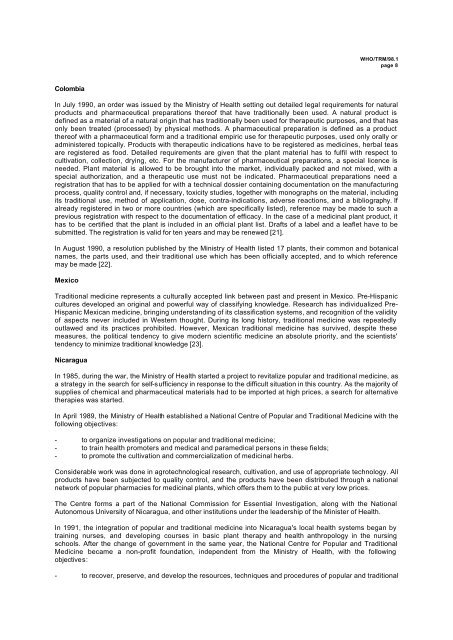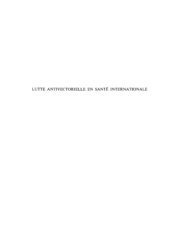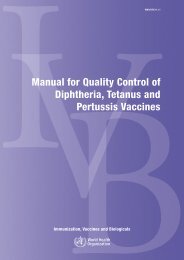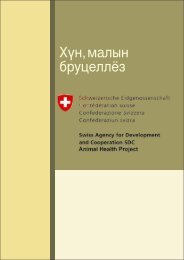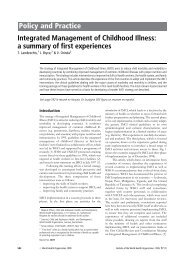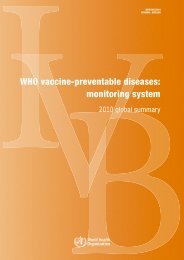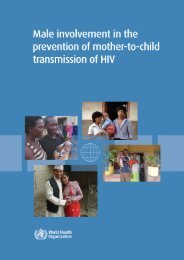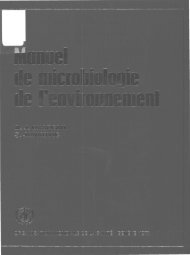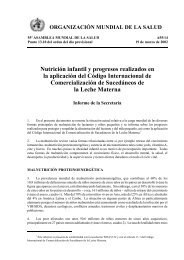Regulatory Situation of Herbal Medicines A worldwide Review
Regulatory Situation of Herbal Medicines A worldwide Review
Regulatory Situation of Herbal Medicines A worldwide Review
Create successful ePaper yourself
Turn your PDF publications into a flip-book with our unique Google optimized e-Paper software.
WHO/TRM/98.1page 8ColombiaIn July 1990, an order was issued by the Ministry <strong>of</strong> Health setting out detailed legal requirements for naturalproducts and pharmaceutical preparations there<strong>of</strong> that have traditionally been used. A natural product isdefined as a material <strong>of</strong> a natural origin that has traditionally been used for therapeutic purposes, and that hasonly been treated (processed) by physical methods. A pharmaceutical preparation is defined as a productthere<strong>of</strong> with a pharmaceutical form and a traditional empiric use for therapeutic purposes, used only orally oradministered topically. Products with therapeutic indications have to be registered as medicines, herbal teasare registered as food. Detailed requirements are given that the plant material has to fulfil with respect tocultivation, collection, drying, etc. For the manufacturer <strong>of</strong> pharmaceutical preparations, a special licence isneeded. Plant material is allowed to be brought into the market, individually packed and not mixed, with aspecial authorization, and a therapeutic use must not be indicated. Pharmaceutical preparations need aregistration that has to be applied for with a technical dossier containing documentation on the manufacturingprocess, quality control and, if necessary, toxicity studies, together with monographs on the material, includingits traditional use, method <strong>of</strong> application, dose, contra-indications, adverse reactions, and a bibliography. Ifalready registered in two or more countries (which are specifically listed), reference may be made to such aprevious registration with respect to the documentation <strong>of</strong> efficacy. In the case <strong>of</strong> a medicinal plant product, ithas to be certified that the plant is included in an <strong>of</strong>ficial plant list. Drafts <strong>of</strong> a label and a leaflet have to besubmitted. The registration is valid for ten years and may be renewed [21].In August 1990, a resolution published by the Ministry <strong>of</strong> Health listed 17 plants, their common and botanicalnames, the parts used, and their traditional use which has been <strong>of</strong>ficially accepted, and to which referencemay be made [22].MexicoTraditional medicine represents a culturally accepted link between past and present in Mexico. Pre-Hispaniccultures developed an original and powerful way <strong>of</strong> classifying knowledge. Research has individualized Pre-Hispanic Mexican medicine, bringing understanding <strong>of</strong> its classification systems, and recognition <strong>of</strong> the validity<strong>of</strong> aspects never included in Western thought. During its long history, traditional medicine was repeatedlyoutlawed and its practices prohibited. However, Mexican traditional medicine has survived, despite thesemeasures, the political tendency to give modern scientific medicine an absolute priority, and the scientists'tendency to minimize traditional knowledge [23].NicaraguaIn 1985, during the war, the Ministry <strong>of</strong> Health started a project to revitalize popular and traditional medicine, asa strategy in the search for self-sufficiency in response to the difficult situation in this country. As the majority <strong>of</strong>supplies <strong>of</strong> chemical and pharmaceutical materials had to be imported at high prices, a search for alternativetherapies was started.In April 1989, the Ministry <strong>of</strong> Health established a National Centre <strong>of</strong> Popular and Traditional Medicine with thefollowing objectives:- to organize investigations on popular and traditional medicine;- to train health promoters and medical and paramedical persons in these fields;- to promote the cultivation and commercialization <strong>of</strong> medicinal herbs.Considerable work was done in agrotechnological research, cultivation, and use <strong>of</strong> appropriate technology. Allproducts have been subjected to quality control, and the products have been distributed through a nationalnetwork <strong>of</strong> popular pharmacies for medicinal plants, which <strong>of</strong>fers them to the public at very low prices.The Centre forms a part <strong>of</strong> the National Commission for Essential Investigation, along with the NationalAutonomous University <strong>of</strong> Nicaragua, and other institutions under the leadership <strong>of</strong> the Minister <strong>of</strong> Health.In 1991, the integration <strong>of</strong> popular and traditional medicine into Nicaragua's local health systems began bytraining nurses, and developing courses in basic plant therapy and health anthropology in the nursingschools. After the change <strong>of</strong> government in the same year, the National Centre for Popular and TraditionalMedicine became a non-pr<strong>of</strong>it foundation, independent from the Ministry <strong>of</strong> Health, with the followingobjectives:- to recover, preserve, and develop the resources, techniques and procedures <strong>of</strong> popular and traditional


